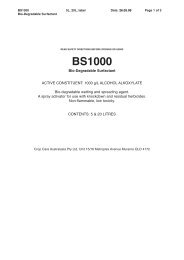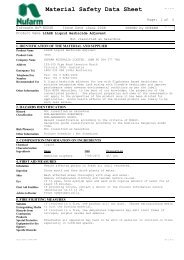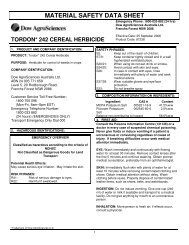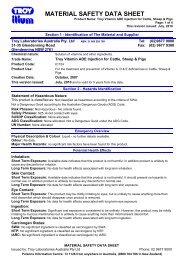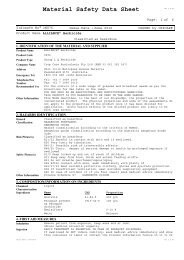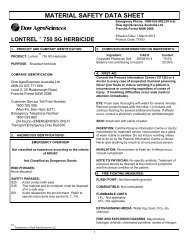Label - Agsure
Label - Agsure
Label - Agsure
- No tags were found...
Create successful ePaper yourself
Turn your PDF publications into a flip-book with our unique Google optimized e-Paper software.
GENERAL INSTRUCTIONSFARMOZ VENOM 100 EC Insecticide/Miticide is a contact and residualinsecticide/miticide. It can be used as a protective treatment whenapplied at regular intervals or as a knockdown treatment to controlexisting pests.Best results are obtained when VENOM 100 EC is applied before pestpopulations build up to damaging levels.This product is not suitable for use in Integrated Pest Management(IPM) programme where mite predators are established and providingeffective mite control.APPLICATIONVENOM 100 EC may be applied by either ground or aircraft. Thoroughcoverage is essential to ensure adequate control.DO NOT apply as a fog or mist.1. Tree and Vine CropsDilute SprayingUse a sprayer designed to apply high volumes of water up to the pointof run-off and matched to the crop being sprayed. Set up and operatethe sprayer to achieve even coverage throughout the crop canopy.Apply sufficient water to cover the crop to the point of run-off. Avoidexcessive run-off. The required water volume may be determined byapplying different test volumes, using different settings on the sprayer,from industry guidelines or expert advice. Add the amount of productspecified in the Directions For Use table for each 100 L of water. Sprayto the point of run-off. The required dilute spray volume will changeand the sprayer set up and operation may also need to be changed, asthe crop grows.Concentrate SprayingUse a sprayer designed and set up for the concentrate spraying (thatis a sprayer which applies water volumes less than those required toreach the point of run-off) and matched to the crop being sprayed. Setup and operate the sprayer to achieve even coverage throughout thecrop canopy using your chosen water volume. Determine anappropriate dilute spray volume (See Dilute Spraying above) for thecrop canopy. This is needed to calculate the concentrate mixing rate.The mixing rate for concentrate spraying can then be calculated in thefollowing way:EXAMPLE ONLY1. Dilute spray volume as determined above: For example 1500 L/ha.2. Your chosen concentrate spray volume: For example 500 L/ha.3. The concentration factor in this example is: 3x (ie 1500 L ÷ 500 L = 3).4. If the dilute label rate is 10 mL/100 L, then the concentrate ratebecomes 3 x10, that is 30 mL/100 L of concentrate spraying.The chosen spray volume, amount of product per 100 L of water, andthe sprayer set up and operation may need to be changed as the cropgrows.For further information on concentrate spraying, users are advised toconsult relevant industry guidelines, undertake appropriatecompetency training and follow industry Best Practices.2. Other CropsGround Application: Applications should be made as a fine spraypreferably using hollow cone nozzles and a droplet size of 150 to 200microns. The application volume will depend on the type of crop to betreated. The following are suggested:Low volume broadacre applications to – e.g. cereals, canola, grainlegumes, lucerne, subterranean clover: 50-200 L/ha.Low volume row crops applications to cotton, tomatoes, navy beans:50-200 L/ha.High volume applications to row crops – e.g. trellised tomatoes:200-1000 L/ha except as noted in critical comments. Use 200 L/ha fromtransplanting increasing to 1000 L/ha at maturity.Grapes: Apply by hand application, using a high volume coarse sprayof 500mL/vine. (e.g. at approx. 2500 vines/ha = 1250L/ha)High volume application to stone fruit: 1000 to 2000 L/ha.Foliar sprays to bananas: 300 to 500 L/haSOIL APPLIED SPRAYSHigh Volume ApplicationBananas:Stool treatment: Apply as a coarse spray at 500-750 mL per stool.Band treatment: Apply as a band application with a side delivery boomand offset nozzles – 1 L of spray solution per stool.Citrus: Apply as a high volume, directed spray to the ground undereach tree. For optimum control apply to both sides of the tree. Totalspray volume should be 5 to 10 L/tree (e.g. at 250 trees/ha = 1250 to2500L/ha).IN FURROW APPLICATIONSCotton & Sugarcane: Use a coarse spray: 60 to 100 L/ha as a band overthe seed or sett before covering with soil – refer to critical commentsfor details.AERIAL APPLICATIONSUse at least 20 L/ha of total spray volume. Spray during the coolerparts of the day or night. To reduce possibility of drift avoid spraying incalm conditions or when wind is light and variable. Preferably, spray ina crosswind. Use suitable application equipment and/or nozzles todeliver a fine spray with a droplet size of 150 to 200 microns.A spraydrift minimisation strategy should be employed at all timeswhen aerially applying sprays to, or near, sensitive areas. The strategyenvisaged is best exemplified by the cotton industry’s BestManagement Practice manual.MONITORINGPost-emergence monitoring of Citrus Leafeating Weevil populations:At first sign of major beetle emergence in mid-October commencemonitoring at 1 to 2 week intervals.Place polystyrene fruit box (330 x 480 mm) under tree, shake branchesvigorously, repeat on ten randomly selected trees throughout orchid.If 25 beetles or more are recorded in consecutive counts, treatment isrequired.MIXINGAdd the required quantity of VENOM 100 EC to water in the spray tankand mix thoroughly. Maintain agitation during mixing and application.COMPATIBILITYVENOM 100 EC is compatible with commonly used fungicides such asAntracol † , Fung-o-nil ® , and the herbicides Sprayseed † , Broadstrike † ,Spinnaker † , FARMOZ Simazine 500, Clincher ® , FARMOZ Metribuzin,Wipe-Out ® , Lonestar ® and Stomp † .SURFACTANTSAdditional surfactant may only be necessary on hard to wet plants andin high volume situations. Wetspay 1000 is recommended at labelrates.NOTICE: Helicoverpa (= Heliothis) armigera resistance in NorthernNSW and Qld. To help contain pyrethroid resistance in H. armigera, theSummer Crop Insecticide strategy as developed by the Qld Departmentof Primary Industries and NSW Agriculture should be adhered to.Failure to observe the strategy may result in widespread resistanceaffecting the future viability of summer cropping.INSECTICIDE RESISTANCE WARNINGFARMOZ VENOM ® 100 EC Insecticide/ GROUPMiticide is a Group 3A insecticide.3A INSECTICIDESome naturally occurring insect biotypes resistant to VENOM 100 ECand other Group 3A insecticides may exist through normal geneticvariability in any insect population. The resistant individuals caneventually dominate the insect population if VENOM 100 EC or otherGroup 3A insecticides are used repeatedly. The effectiveness ofVENOM 100 EC on resistant individuals could be significantly reduced.Since the occurrence of resistant insects is difficult to detect prior touse, FARMOZ Pty. Ltd. accepts no liability for any losses that mayresult from the failure of VENOM 100 EC to control resistant insects.VENOM 100 EC may be subject to specific resistance managementstrategies. For further information contact your local supplier, FARMOZrepresentative or local agricultural department agronomist.STONE FRUIT EXPORT ADVICEExport of Treated Stone Fruit – Some export markets do not havesuitable Maximum Residue Limits or import tolerances in place. Pleasecontact FARMOZ Pty. Ltd. or the Australian Fresh Stone Fruit GrowersAssociation prior to using this product on crops destined for export.RE-ENTRY TO TREATED FIELDS/CROPSDO NOT re-enter treated field/crop until spray deposits have dried,unless wearing suitable protective clothing (ie. waterproof hat,overalls, boots and gloves).PROTECTION OF WILDLIFE, FISH, CRUSTACEANS ANDENVIRONMENTDangerous to fish and aquatic organisms. DO NOT contaminate dams,rivers, streams, waterways or drains with this product or the usedcontainer. Tail drains which flow from treated areas should beprevented from entering river systems.PROTECTION OF LIVESTOCKDangerous to bees. DO NOT spray any plants in flower when bees areforaging. Spray in the early morning when bees are not activelyforaging.STORAGE AND DISPOSAL (1 L)Store in the closed, original container in a cool, well ventilated area.DO NOT store for prolonged periods in direct sunlight. Triple orpreferably pressure rinse containers before disposal. Add rinsings tospray tank. DO NOT dispose of undiluted chemicals on site. Ifrecycling, replace cap and return clean containers to recycler ordesignated collection point. If not recycling, break, crush or punctureand bury empty containers in a local authority landfill. If no landfill isVenom 100 EC Page 5 of 6



